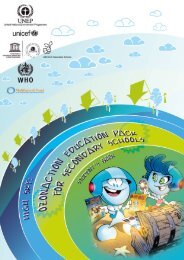Chapter 2. Progress towards the EFA goals - Unesco
Chapter 2. Progress towards the EFA goals - Unesco
Chapter 2. Progress towards the EFA goals - Unesco
You also want an ePaper? Increase the reach of your titles
YUMPU automatically turns print PDFs into web optimized ePapers that Google loves.
PROGRESS TOWARDS THE <strong>EFA</strong> GOALS<br />
Estimating <strong>the</strong> cost of achieving Education for All<br />
Estimating <strong>the</strong> cost<br />
of achieving Education<br />
for All<br />
The Dakar Framework for Action includes strong<br />
commitments on education financing. Developing<br />
countries pledged to ‘enhance significantly<br />
investment in basic education’ (para. 8[i]), while rich<br />
nations promised an increase in aid, mainly in <strong>the</strong><br />
form of grants and concessional finance, to ensure<br />
that ‘no countries seriously committed to education<br />
for all will be thwarted in <strong>the</strong>ir achievement of this<br />
goal by a lack of resources’ (para. 10).<br />
Ten years later, finance remains a major barrier<br />
to Education for All. Developing countries have<br />
stepped up <strong>the</strong>ir efforts to make domestic<br />
resources available, albeit on an uneven basis.<br />
Many could do much more to raise <strong>the</strong>ir<br />
investment in education by streng<strong>the</strong>ning revenue<br />
collection and equity in public spending. The<br />
international community has also increased aid<br />
for basic education, but collectively donors have<br />
fallen far short of delivering on <strong>the</strong>ir commitments<br />
made in Dakar.<br />
This section assesses <strong>the</strong> scale of <strong>the</strong> Education<br />
for All financing gap. It sets out <strong>the</strong> results of a<br />
costing exercise covering forty-six low-income<br />
countries. 49 The exercise looks at <strong>the</strong> financing<br />
requirements for achieving a range of <strong>goals</strong> in basic<br />
education and beyond. Among <strong>the</strong> key findings:<br />
The financing gap is far larger than previously<br />
assumed. Even with an increased domestic<br />
resource mobilization effort, low-income<br />
countries face a financing gap of about<br />
US$16 billion for basic education (literacy,<br />
pre-primary and primary education),<br />
representing 1.5% of <strong>the</strong>ir collective GDP. 50<br />
This is a third higher than <strong>the</strong> previous estimate.<br />
Factoring in lower secondary education would<br />
increase <strong>the</strong> gap to US$24 billion.<br />
Low-income countries need to streng<strong>the</strong>n<br />
efficiency and equity in education financing.<br />
There is considerable scope for making more<br />
domestic resources available by improving<br />
revenue collection, giving education a higher<br />
priority and focusing more on basic education.<br />
Increased revenue collection and greater equity<br />
could enhance domestic financing for basic<br />
education by about 0.7% of GDP. This represents<br />
US$7 billion, or two-thirds of current levels of<br />
spending in <strong>the</strong> countries included in <strong>the</strong> study.<br />
Several countries have <strong>the</strong> potential to double<br />
<strong>the</strong> share of GDP allocated to basic education.<br />
Exploiting that potential should be part of <strong>the</strong><br />
Education for All contract between developing<br />
countries and donors.<br />
Aid donors need to undertake a ‘Gleneagles plus’<br />
aid commitment. Aid levels for basic education<br />
in <strong>the</strong> forty-six countries covered need to rise<br />
sixfold from <strong>the</strong>ir current level, from<br />
US$<strong>2.</strong>7 billion to US$16 billion. 51 Even if<br />
donors act on <strong>the</strong> commitments made at<br />
<strong>the</strong> 2005 Group of Eight summit in Gleneagles,<br />
Scotland, and substantially increase aid to<br />
<strong>the</strong> poorest countries, <strong>the</strong> level will still fall<br />
US$11 billion short. An emergency pledging<br />
conference should be convened to mobilize<br />
<strong>the</strong> additional financing required.<br />
Reaching <strong>the</strong> marginalized requires additional<br />
finance. Failure to take into account <strong>the</strong> costs<br />
associated with reaching marginalized groups<br />
has contributed to systematic underestimation<br />
of <strong>the</strong> financing gap. It costs more to extend<br />
education opportunities to <strong>the</strong> most<br />
disadvantaged than it costs to reach better-off<br />
households. The new study estimates that<br />
additional measures to extend primary school<br />
opportunities to social groups facing extreme<br />
and persistent deprivation will cost<br />
US$3.7 billion annually.<br />
The revised Education for All financing gap<br />
points to challenges for both aid recipients and<br />
donors. Developing countries need to increase<br />
<strong>the</strong> level of ambition for public spending in<br />
education at a time when slower economic growth<br />
is putting budgets under pressure. Most major<br />
donors, for <strong>the</strong>ir part, are gripped by recession and<br />
rising fiscal deficits. Some are cutting aid budgets.<br />
O<strong>the</strong>rs are reviewing future commitments. As <strong>the</strong>se<br />
pressures mount, it is important that governments<br />
recognize <strong>the</strong> crucial role of education investments<br />
in creating <strong>the</strong> foundations for recovery and future<br />
poverty reduction efforts.<br />
Part 1 of this section sets out <strong>the</strong> cost estimates<br />
and <strong>the</strong> assumptions behind <strong>the</strong>m. Part 2 presents<br />
<strong>the</strong> findings on <strong>the</strong> Education for All financing gap.<br />
Ten years after<br />
Dakar, finance<br />
remains a major<br />
barrier to<br />
Education for All<br />
49. Full details of <strong>the</strong><br />
methodology and results<br />
of <strong>the</strong> study are available in<br />
(EPDC and UNESCO, 2009).<br />
50. These figures relate to<br />
average financing gaps and<br />
GDP levels in low-income<br />
countries between 2008<br />
and 2015.<br />
51. <strong>Chapter</strong> 4 reports that<br />
annual aid commitments<br />
to basic education averaged<br />
US$4.9 billion in 2006<br />
and 2007 (see Figure 4.7).<br />
The low-income countries<br />
included in this costing<br />
exercise received 55% of<br />
those commitments and<br />
US$<strong>2.</strong>7 billion of total aid to<br />
basic education. <strong>Chapter</strong> 4<br />
shows that low-income<br />
countries received 60% of<br />
all aid to basic education,<br />
but <strong>the</strong> figure includes some<br />
small countries excluded<br />
from <strong>the</strong> costing exercise,<br />
as well as India, which<br />
<strong>the</strong> OECD-DAC defined as<br />
a low-income country at<br />
<strong>the</strong> time of writing.<br />
119
















